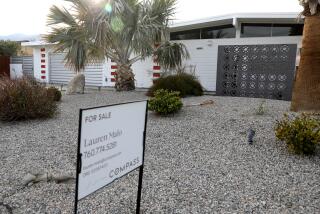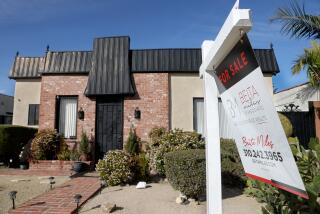Commentary: The next housing bubble could come from this technology

- Share via
A decade after the housing crash, it is now possible to buy or sell a house with the click of a mouse. If the practice catches on, it could lead to a far more efficient and affordable housing market — or another devastating bubble.
So-called iBuying (short for “instant buying”) involves firms using algorithms to provide sellers with fixed-price offers on their homes. Although housing is a good long-term investment, it is bedeviled by multiple instances of market failure. The most fundamental is that the seller has a lot more information about the condition of the property than the potential buyer. Buyers and investors are therefore cautious. Disclosure requirements help, but they are often lengthy and confusing.
This is where the algorithms come in: They read disclosures, do market comparisons, evaluate timing, assess nearby rental vacancies and consider a host of other factors to arrive at an estimate of the home’s value. That enables the iBuying firms to comfortably offer an instant price. Last year in Phoenix, about 5% of the homes were sold through instant buying, and investors own as many as 22,000 houses in the area.
Zillow will buy your home directly. And it just brought the service to Southern California »
But the real potential of iBuying is during the next real estate downturn. As the real estate market slows, the opportunity to sell instantly will become more attractive, and more properties could end up in the hands of big investors.
This ability to sell properties instantly also encourages the adoption of a second technology: click-to-buy. For many of the same reasons big investors have been reluctant to move into the home market, small-time real estate investors traditionally have taken their time and stayed in neighborhoods they know well.
But now online real-estate firms such as Redfin are offering better technology, such as 3-D maps, which enable potential home buyers to purchase sight unseen. A large inventory of homes owned by respected firms would add liquidity to this market, enabling small investors to get in and out more easily.
Together, these two technologies could serve as a kind of market-maker: a platform that helps buyers and sellers find each other. As an asset that can be easily bought and sold at known prices, real estate would be coveted by investors, who are willing to accept a lower return on their investment in exchange for the convenience of easy trading.
The yield on an asset is its price divided by the yearly cash flow it generates. For stocks, the cash flow is dividends. For houses, it is rental income. Housing investors have generally considered a price-to-rent ratio of 12 to 15 as a good investment. That corresponds to a yield of 7% to 9%. On the other hand, the average dividend yield on stocks is about 2%, corresponding to a price-to-dividend ratio of just over 50.
So what would happen if houses became as easy to trade as stocks? At first, the price of homes would soar. That happened during the last housing bubble, when lower lending standards added liquidity to the housing market by making it easier for investors to sell quickly to less qualified borrowers.
At the peak of the housing bubble, the average price-to-rent ratio in the United States rose to about 21, well outside the range that housing investors consider safe. The existence of a market-maker in housing, however, could drive yields down to the level of stocks, creating a potential bubble twice as big as the one that occurred in the early 2000s.
A lot depends on how the home construction market responds if this new technology catches on. With homes selling at 50 times yearly rent, the incentive to build more homes would be huge. Investment would flock to home construction, expanding supply and pushing down both prices and rents. The price-to-rent ratio would remain high, but because rents were falling, home prices would eventually come down to affordable levels.
On the other hand, if the supply of houses did not expand, then housing prices would stay elevated — and investors would eventually crowd out owner-occupiers in the housing market. The United States would become a nation of (mostly) renters.
A rigid supply of housing would also make prices more volatile. During good times, housing prices would soar, just as prices do in the stock market. In bad times, prices would crash. That volatility could add permanent instability to the U.S. economy.
In either case, emerging technology has the potential to radically transform the economics of housing. It could lead to an expansion of supply, making housing more affordable, or it could result in the financialization of housing, the end of the owner-occupied era and a new source of economic instability. Policymakers will have to keep an eye out for which scenario is emerging and decide what, if anything, to do about it.
Smith writes for Bloomberg Opinion.
More to Read
Inside the business of entertainment
The Wide Shot brings you news, analysis and insights on everything from streaming wars to production — and what it all means for the future.
You may occasionally receive promotional content from the Los Angeles Times.










